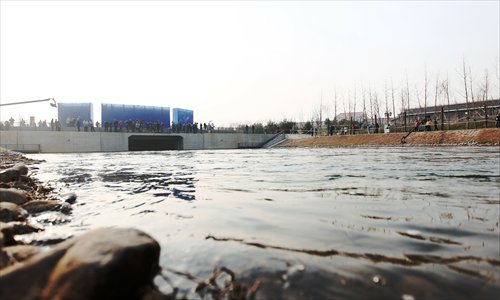Mega project water arrives in Beijing
Expert rebuffs feasibility, environmental concerns over South-North transfer

A man-made watercourse at Tuancheng Lake in Beijing as first flow from the South-to-North Water Diversion Project reaches China's capital on Saturday. Photo: Cui Meng/GT
Beijing received over the weekend its first flow from the South-to-North Water Diversion Project, a project meant to gradually solve chronic water shortages in northern China.
The delivery marks the completion of the middle route's first stage, construction of which began 12 years ago.
Authorities in Beijing confirmed that the quality of the water supplied via the project meets national drinking water standards.
The capital city currently on average consumes 3.6 billion cubic meters of water annually. The project will eventually deliver 1 billion cubic meters of water to Beijing. Beijing's per-capita water resources are about one-eightieth the world average.
"The project will not completely solve the water shortage in northern China, but it will alleviate the problem, in particular helping to decrease the use of groundwater reserves, which are unrecoverable by natural means," Mu Jianxin, a senior engineer from the Department of Irrigation and Drainage with the China Institute of Water Resources and Hydropower Research, told the Global Times.
It will also help to assuage persistent flooding in the South, she added.
Water from the South is expected to replace the existing practice of tapping into the city's dwindling groundwater reserves. Authorities expect water from the South to eventually be delivered to 80 percent to 90 percent of Beijing's flatlands.
The project, which will ultimately have three routes and cost around $81 billion, is the second-biggest water project undertaken by China after the Three Gorges Dam, the world's largest hydropower dam.
Analysts believe the project is also a milestone for northern China's industrialization and modernization.
"The project will help improve industrial, agricultural and environmental development in northern China, where water-intensive industries, including iron and steel plants, mining, and nuclear plants, are located," Han Meng, a research fellow of the Institute of Economics of the Chinese Academy of Social Sciences, told the Global Times.
Industries in Beijing, Tianjin, and Hebei Province urgently need water to support their development, he added.
The project is also a strategic move on the part of the central government meant to balance China's water supplies, said Han, as reduced dependence on groundwater will allow aquatic ecosystems in the North to slowly recover, while he expects pollution-intensive industries will increasingly move out of Beijing, citing the Shougang Group, one of China's largest steel companies, moving its operations to neighboring Hebei Province in 2005 as an example.
Sea water desalinization is another move on the part of authorities to balance water supplies, said Han, citing intensive government-led research efforts on that front.
Concerns persist around the project's environmental impact and sustainability.
Environmentalists are worried that the project's pipelines might damage the ecosystems of hundreds of rivers in northern China.
A recent post by a Web user named "Ma Ke'an," who claims to hold a doctorate in physics, claimed the average flow rate and carrying capacity of the project has failed to meet the original objective.
He also argued that the water may freeze en route and fail to arrive in Beijing, and river sediment will eventually destroy the middle route of the water project.
His comments were quickly rebutted by Wang Hao, an academician with the Chinese Academy of Engineering, who said Ma's methods were "unreliable," and that he had reached an "unscientific conclusion," counter to official calculations.
Xinhua contributed to this story